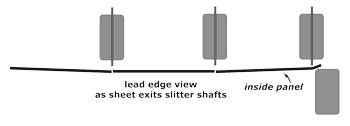 A scenario notorious for causing 'dog ears' (bent corners) is the 11x17" brochure which first folds in half and then folds 2x at a right angle to fit a #10 envelope. It’s common to get an unsightly ‘dog ear’ or bent corner on the inside flap (fig. 1)
A scenario notorious for causing 'dog ears' (bent corners) is the 11x17" brochure which first folds in half and then folds 2x at a right angle to fit a #10 envelope. It’s common to get an unsightly ‘dog ear’ or bent corner on the inside flap (fig. 1)
There are a couple ways to fold this, but for our illustration we’re using fold plate #1 in the parallel section and then going up in to plates #1 and #3 in the right angle section. If you use another configuration, simply move the score wheels as needed—the concept works for any folding machine setup.
A “How’d They Do That” Solution
Often the folder operator will struggle with adjusting the fold, trimming more off the sheet (you can’t go back from that one!) or playing with the fold plates. Some or all of these can indeed work, but it is tedious and there could be limitations due to folding on a bleed, or copy that is close to a trimmed edge.
Before struggling with these folding machine variations, try adding a slight up-curl to the inside panel where the dog ear would normally occur, to curl it the opposite direction. Do this by using a regular scoring wheel against a single scoring block (or pull out wheel) as shown. The curl that is created keeps the inside panel nicely tucked on the second
where the dog ear would normally occur, to curl it the opposite direction. Do this by using a regular scoring wheel against a single scoring block (or pull out wheel) as shown. The curl that is created keeps the inside panel nicely tucked on the second fold. You’ll find that you can tuck the panel in so tightly that it will leave others wondering how you did it. An added bonus…you’ll be able to run the job faster.
fold. You’ll find that you can tuck the panel in so tightly that it will leave others wondering how you did it. An added bonus…you’ll be able to run the job faster.
For best results, experiment with the distance of the score from the edge of the sheet, and with the distance of the male score wheel horizontally from the score block (making the score sharper or softer.) While this bindery tip might take a few extra minutes in the folding machine setup, the payoff is huge in reduced troubleshooting time, higher folder productivity and customer satisfaction.

